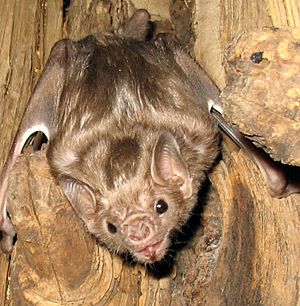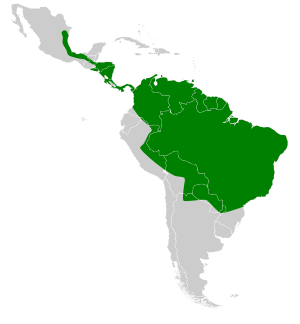White-winged vampire bat facts for kids
Quick facts for kids White-winged vampire bat |
|
|---|---|
 |
|
| Conservation status | |
| Scientific classification | |
| Genus: |
Diaemus
|
| Species: |
youngi
|
 |
|
| Range map | |
The white-winged vampire bat (Diaemus youngi) is a special kind of vampire bat. It's the only bat in its group, called Diaemus. You can find these bats from Mexico all the way down to northern Argentina. They also live on the islands of Trinidad and Margarita.
Contents
About Their Name and Family Tree
How the Bat Got Its Name
The white-winged vampire bat was first described by a Dutch animal expert named Fredericus Anna Jentink in 1893. He named the species youngi to honor Dr. Charles Grove Young. Dr. Young had given many animal samples from British Guiana to the museum where Jentink worked.
Its Place in the Bat Family
When Jentink first described this bat, he put it in the same group as the common vampire bat, called Desmodus. But in 1907, another scientist, Gerrit Smith Miller Jr., decided it needed its own new group, Diaemus. It took a while for everyone to agree with this change. Some scientists still put it in the Desmodus group until the 1980s.
What They Look Like
Body and Fur
These bats have fur that can be clay-colored, light brown, or dark cinnamon brown. The edges of their wings are white. Also, the skin between their second and third fingers is white.
Ears and Thumbs
Their ears are longer than they are wide, about 18 mm long. The front part of their ear, called the tragus, has hair on it. Its outer edge is smooth, which is different from the common vampire bat, whose tragus has a jagged edge. Their thumb is much shorter than the common vampire bat's thumb. Their forearms are about 51 to 54 mm long.
Teeth and Size
The white-winged vampire bat has 22 teeth. This makes it the only bat species in the world with exactly 22 teeth. The common vampire bat has 20 teeth, and the hairy-legged vampire bat has 26. The last upper molars are very small and sometimes fall out in older bats. From their nose to their tail, they are about 84 mm long. They usually weigh between 31.7 and 48.1 g.
Special Features
Both male and female bats have cup-shaped scent glands inside their mouths. When these bats are bothered, they can make a bad smell from these glands. This might help protect them from predators. Their brains are quite large compared to their body size. This might be because they need to think carefully when they hunt, like staying quiet and hidden. Their eyes are also quite big for their body size.
Life and Habits
What They Eat
Like other vampire bats, their saliva has special chemicals. These chemicals stop blood from clotting quickly. This helps them drink blood easily from their prey. These chemicals work especially well on birds. Birds are their favorite food, but they will also feed on mammals like goats and cattle.
Health and Movement
White-winged vampire bats can carry rabies, but it's not very common for them to spread it. So far, rabies transmission from this bat has only been reported in Trinidad. They are not as good at walking on the ground as common vampire bats. This is probably because their thumbs are much shorter. However, they are very good at climbing trees.
Reproduction
Female white-winged vampire bats can get pregnant many times a year. They usually give birth to one baby bat at a time.
Where They Sleep
These bats often share their roosts (sleeping spots) with many other types of bats. Some of these include the greater sac-winged bat, lesser dog-like bat, big-eared woolly bat, tailed tailless bat, Seba's short-tailed bat, little yellow-shouldered bat, great fruit-eating bat, white-lined broad-nosed bat, Pallas's long-tongued bat, Handley's nectar bat, white-bellied big-eared bat, greater spear-nosed bat, Parnell's mustached bat, Wagner's mustached bat, buffy broad-nosed bat, and the common vampire bat.
Where They Live
Countries and Habitats
You can find white-winged vampire bats in many countries. These include Argentina, Bolivia, Brazil, Colombia, Costa Rica, Ecuador, El Salvador, French Guiana, Guatemala, Guyana, Mexico, Nicaragua, Panama, Paraguay, Peru, Suriname, Trinidad and Tobago, and Venezuela. They can live in many different kinds of places and find food in various environments. They like wet, open areas, but they can also find food in dry forests. They will sleep in holes in trees or in caves.
Looking After Them
Conservation Status
The IUCN always lists the white-winged vampire bat as a species of least concern. This means they are not currently in danger of disappearing. Even though people don't see them very often, they live in many different places and can adapt to various habitats. Scientists believe there are many of them in the wild.
In Captivity
These bats can be kept and cared for by humans. In zoos or special centers, they are fed cow and chicken blood. The blood needs to be treated so it doesn't clot. Each bat drinks about 16 ml of blood every day. They are social animals, so they should be kept in groups. These groups often have a leader or a pecking order.
See also
 In Spanish: Vampiro de alas blancas para niños
In Spanish: Vampiro de alas blancas para niños


